Performance analysis of blockchain for civil aviation business data based on M/G/1 queuing theory①
2022-01-09LiuYiwei刘逸玮ZhangYanhuaYangRuizheGaoYuanZhangXuanyi
Liu Yiwei(刘逸玮),Zhang Yanhua,Yang Ruizhe②,Gao Yuan,Zhang Xuanyi
(*Faculty of Information Technology,Beijing University of Technology,Beijing 100124,P.R.China)
(**Beijing Laboratory of Advanced Information Networks,Beijing University of Technology,Beijing 100124,P.R.China)
(***Beijing Capital International Airport Co.Ltd,Beijing 100621,P.R.China)
Abstract
Key words:blockchain,Ethereum,proof of stake(PoS)consensus mechanism,M/G/1 queuing theory,priority
0 Introduction
In recent years,with the expansion of the airport,the number of passengers has been sharply increasing,which set a higher request for the informatization ability of civil aviation.Constructing airport groups has become the key to promote the airport data sharing.
Blockchain technologies create a decentralized,trustless,transparent and tamper-proof environment for building applications in various areas,which meets the demand of the data sharing within airport groups[1].In the weak-trust environment of blockchain system,nodes are allowed to join and exit freely without central authority,which establishes a trust mechanism to ensure the openness,transparence,traceability and unforgeability through the distributed storage,consensus mechanism,point-to-point(P2P)communication,encryption algorithm and other technologies.
Bitcoin,which is the first blockchain that gets attention has solved the double spending of electronic currency.Inspired by Bitcoin and Ethereum,a platform with mature turing-complete programming language proposed in 2013 allows users to write their own smart contracts,which leads the progress from centralized control to decentralized control[2].
Based on the technical feature of blockchain and the urgent need of civil aviation data sharing,Society International De Telecommunicatioan Aero-nautiques(SITA)took the lead in proposing the concept of intelligent access with blockchain technology in 2016,and jointly launched a pilot project called Flight-Chain with British Airways,London Heathrow Airport,Geneva Airport and Miami Airport to realize data sharing.At the same time,Dnata,an aviation and travel service provider in the Middle East,cooperated with IBM and other companies to carry out the blockchain technology in air pilot projects.Air France explored the use of blockchain to track aircraft maintenance workflow.Russian S7 Airlines proposed to use blockchain technology to solve the ticket problem.Dubai Airport planned to combine biometric verification with blockchain to achieve passport-free service.In 2018,the world’s first aviation ecological blockchain application project called Airline and Life Networking Token came into being.International Air Transport Association(IATA),Google and other partners jointly announced the Known Passenger Digital Identity Concept based on blockchain,and planned to launch a pilot project of concept verification between Canada and the Netherlands.Brussels Airport launched an application based on blockchain to track the movement of goods from the process on the ground to freight agent.Singapore Airlines,together with KPMG and Microsoft,applied blockchain to the digital wallet of its frequent passenger program KrisFlyer[3].
The airport group in China is under construction,and solutions of data sharing within airlines and airports have been proposed.However,most of the airport data is still stored independently,which leads to the lack of information interaction within airports.To the issues discussed above,the blockchain for civil aviation business data based on Ethereum is proposed.It uses smart contracts to develop a data sharing platform for both airports and passengers,which provides a variety of business applications,including self-service check-in,flight query,luggage traceability and E-commerce.The authenticity and unforgeability are ensured by packing the data to the blockchain.
Different from the fixed block size of blockchain for Bitcoin,a dynamic adjustment mechanism called Block Gas Limit is introduced by Ethereum,that is,the Block Gas Limit can be adjusted according to the transaction number to control the transaction throughput.At present,as for the analysis of theoretical model for blockchain,Refs[4-6]used M/G/1 queuing theory to model the confirmation process of Bitcoin,and established the joint distribution of transaction quantity and service time in the queue,and discussed the influence of transactions arrival rate and block capacity on transactions confirmation time.Ref.[7]proposed a random batch-service process including block generation and blockchain construction which improved the queueing model of Ref.[5].By solving GI/M/1 continuous Markov process,the number of transactions in the queue,the number of transactions in blocks and the average transactions confirmation time were obtained[7-8].Ref.[9]proposed a framework consisting of machine learning and queuing theory to identify which transaction will be confirmed in the block.Ref.[10]simulated the mining process of Bitcoin system by using queuing theory.Refs[11-12]established a game theory model for the transaction priority mechanism formed by Bitcoin transaction fee,and analyzed the decisionmaking of the specified transaction cost of users.Ref.[13]proposed a mathematical model to analyze the evolution of block arrival and mining difficulty with time.The work above mainly focused on the Bitcoin transactions confirmation process,while there were few work about the performance analysis of Ethereum blockchain based on proof of stake(PoS)consensus mechanism,especially the impact of dynamic adjustment of Gas.
This paper takes Ethereum as the platform and adopts PoSconsensus mechanism to build a blockchain for civil aviation business data to promote data sharing between internal information of airport group and service platform for users.Considering the constraint of Block Gas Limit and Gas consumption of transactions,the transactions confirmation process is modeled as a batch-service M/G/1 queueing system with a variable threshold.The number of transactions in the transaction pool at the moment before the current block has been generated is analyzed as a discrete-time Markov chain.Transactions are given different priority according to their Gas Price,and the average confirmation time of transactions with different priority is quantitatively described.Combined with the requirements of the platform for airport groups,the comparison of average confirmation time of transactions with high and low priority in blockchain is given by the simulation,which confirms the availability of the theoretical model for adjusting the parameters of Ethereum blockchain to optimize the transactions confirmation time.
1 System model
1.1 Working principle of blockchain for civil aviation business data
As shown in Fig.1,the blockchain for civil aviation business data takes each airport as a node to record the passengers’behavior.Each passenger in the airport groups can be regarded as a light node which can record consumption,trips and inquire travel information,such as flight and luggage.
As shown in Fig.2,the civil aviation business data in blockchain mainly consists of the following two parts.The first part is the information of civil aviation airport groups,including flight,route,luggage,etc.,which is provided by the internal operation platform of each airport group,and uploaded to the blockchain periodically.The second part is the information of passengers which records the process of passengers using DAPP to initiate and inquire transactions.A distinct transaction ID will be generated after a transaction has been initiated.The date,location,longitude and latitude coordinates of the transaction can be automatically uploaded to the corresponding airport node.Self-service check-in,flight inquiry,baggage tracking and air E-commerce are included in the main functions of DAPP.On the one hand,the server of the blockchain system provides an interface for data inquiry operation.Passengers can obtain their own related information from the blockchain through DAPP,including the flight information and baggage transportation process.On the other hand,passengers can buy or book the products sold by each airport in the air E-commerce before boarding.

Fig.1 System architecture of the blockchain for civil aviation business data

Fig.2 System layers of the blockchain for civil aviation business data
1.2 Queueing model of blockchain system
1.2.1 Analysis of transaction arriving and service process
When an airport noden(miner node)receives the latest transactions submitted by local or broadcasted by other nodes,it will cache the transactions in its transaction pool,sort and verify the transactions according to the priority mechanism.Once the key Nonce is provided(the difficulty of finding a Nonce is related to the currency age of the node),the node obtains the right to record the ledger of the current block,and then takesBeligible transactions from its transaction pool that have been sorted and verified according to the priority mechanism to form the current block and then broadcast it in the blockchain system.After verifying the block,each node will peg it to its local blockchain.When other nodes find the Nonce before noden,nodenwill no longer compete for finding the current Nonce,but peg the block to its blockchain as the right of keeping the ledger has been obtained by other nodes,and then continue to compete for the right of keeping the ledger of the next block.
Based on the analysis above,this paper supposes that the process of transactions arriving at the transaction pool of any node follows the Poisson distribution with arrival rateλ.At timet,the number of transactions arriving at the transaction pool isbwith the probability as

Based on the relationship between the right of recording the ledger,the currency age accumulation and clearing mechanism in PoS,it is assumed that the Nonce computation timenof each node is an independent distributed random variable(In the practical application of blockchain for civil aviation business data,each airport node has different computing power),so each node has Nonce calculation time of different random distribution parameters.In order to emphasize the impact of the number of nodes on the block generation time,each node is simplified to follow the distribution functionFSn(x),then the average Nonce generation timeE[Sn]of each node can be denoted as

Therefore,the process of each node dealing with transactions in the blockchain can be regarded as a batch-service M/G/1 queuing system with thresholdB.During the time interval from a node packing transactions into a block to the node obtaining the right of keeping the ledger to confirm the block,the new transactions arriving at the node will all remain in the transaction pool rather than enter the current block,even if the number of transactions in the current block does not exceed the block capacity,that is,the new transactions can only be served within the next block generation time of the node,which can be described as Fig.3.
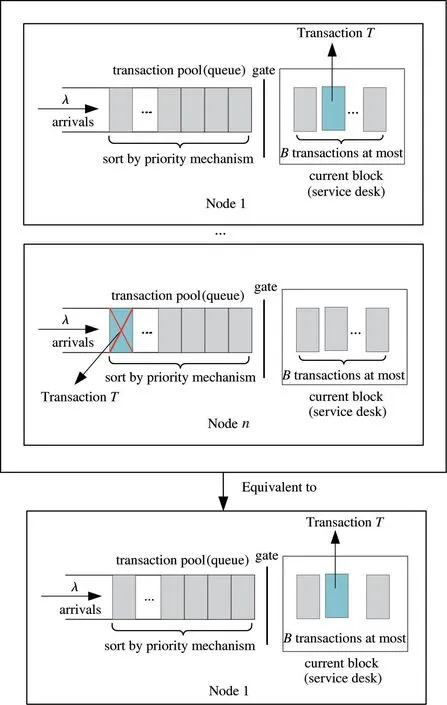
Fig.3 A batch-service M/G/1 queuing system with threshold B



whereNis the number of nodes mining at the same time.
1.2.2 Priority mechanism of transactions
In Ethereum,unlike the blockchain which pays Bitcoin as transaction fee,Ethereum uses Gas as the transaction fee to pay the computation and network resources consumed by nodes in processing transactions.Gas takes the Gas Limit as the maximum amount to be paid,and the Gas Price is the unit price of Gas.From the perspective of maximizing revenue,nodes will give priority to packing transactions with higher Gas Price.Therefore,nodes need to assign different priority to transactions in the transaction pool according to their Gas Price.This paper assumes that nodes divide the priority of the transactions in the transaction pool intoHlevels,whereg→={g→1,g→2,…,g→h,…,g→H,g→H+1},andg→1=∞,g→H+1=0,∞≥g→h>g→h+1≥0,h∈[0,H].The priority of transactions with Gas Pricegfishin the transaction pool only ifg→1>gf≥g→h+1.Transactions with priorityhare non-preemptive to those with priorityewhene>h.Transactions whose Gas Price has not been paid have the minimum priorityH.Transactions with the same priority follow the firstcome-first-served rule.
1.2.3 Maximum block capacity
Ethereum adopts a dynamic adjustment mechanism based on the Block Gas Limit,which is the maximum Gas sum of all transactions in a block.Therefore,the throughput of Ethereum can be calculated as


2 Average transactions confirmation time
2.1 Queueing model of blockchain system
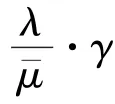
(4)开设就业指导相关课程。在学生入学之初开展专业入学教育专题讲座,让学生明白专业发展方向;在学生离校前的一个学期,开设《职业发展与就业指导》《创业基础》两门课程,让学生做好就业规划。

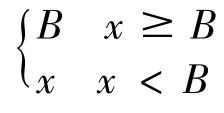

Let{Ak}denote a series of independent and identically distributed(i.i.d)random variables which follow the distribution as

{Lk:k=1,2,…}and{Ak:k=1,2,…}are mutually independent,it can be seen from Eq.(8)that{Lk:k=1,2,…}is a discrete time Markov chain with transition probability as

andpijcan be caculated as

The Markov property of{Lk:k=1,2,…}is determined by the transition probability matrix{pij}.It is easy to know that{Lk:k=1,2,…}is a periodically irreducible[11].According to Markov process,when{Lk:k=1,2,…}is normal return,there exists a stationary distribution{pij}satisfying



can simplified as[14]


According to Little Theorem,the average waiting timeE[W]of transactions in the transaction pool is


The notations used in this section are listed in Table 1.
2.2 Queueing model of blockchain system


can be denoted as the average confirmation time of transactions withmlevel priority.Whenm=1,the average transactions confirmation time is the same as those without considering priority,which can be denoted as.Any transactions with(m+Δ)level priority can not affect their confirmation process,thencan be denoted as

and the average confirmation time of transactions withmlevel priority can be given by

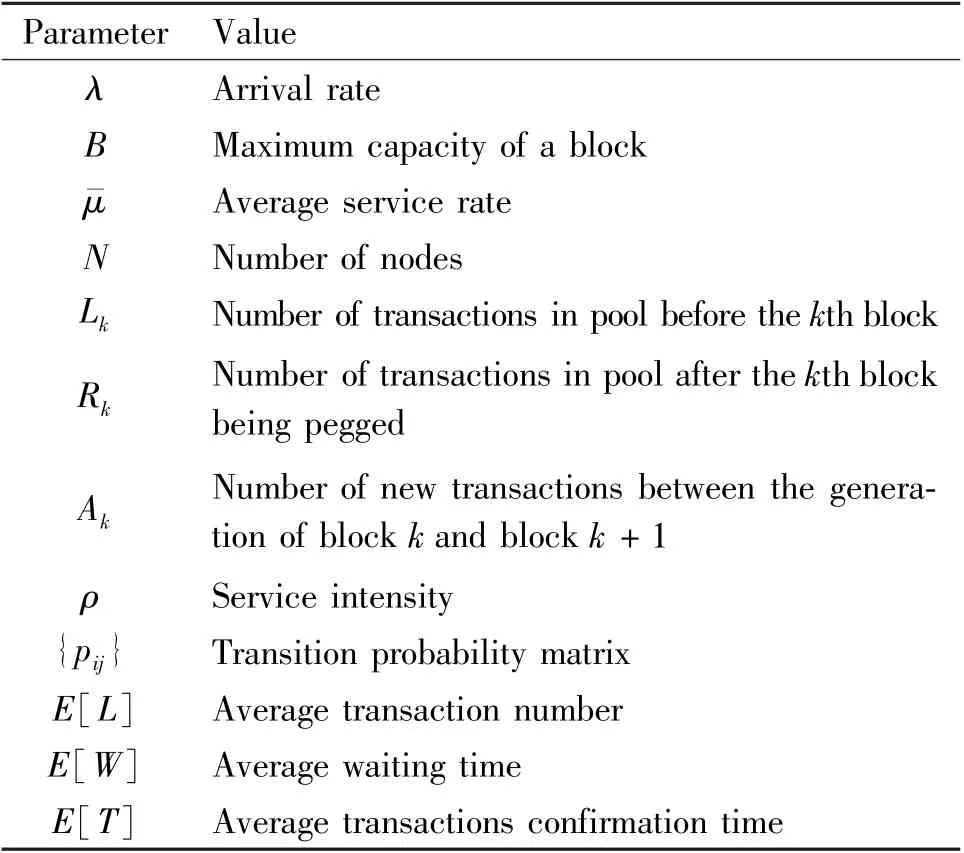
Table 1 Notations
3 Simulation results and discussion
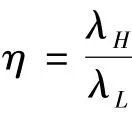
The configuration of the experiment is Intel(R)core(TM)i5-6200u CPU@2.30 GHz(8 CPUs),8 GB ram,Windows 10 professional 64 bit.In order to ensure the stable operation of the simulation,ρ<1 is taken.The related parameters and values involved in the experiment are shown in Table 2.
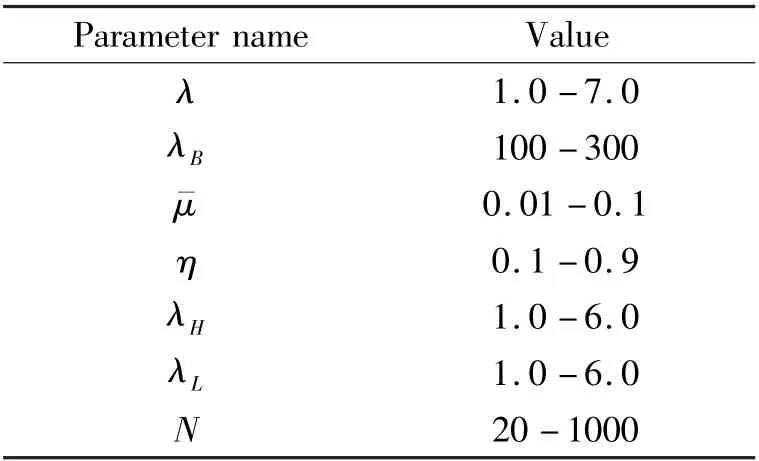
Table 2 Setting of simulation parameter
Fig.4 shows the average confirmation time of transactions with high and low priority under different transactions arrival rateλ(λB=200,μS=0.00042,η=0.8,N=150).It is obvious that the difference between the simulation results and the theoretical analysis is small,and the relationship between transactions arrival rate and average transactions confirmation time can be linear.With the increase of the transactions arrival rate,the difference of the average confirmation time between transactions with high priority and low priority increases gradually.The reason is that when the transactions arrival rate is low,the number of transactions remaining in the transaction pool and the times of the block packing transactions are less,and transactions with high and low priority are more likely to be processed in the same block.When the arrival rate increases to a certain extent,the number of transactions remaining in the transaction pool increases,subsequently transactions with high priority will be earlier packed into the current block and those with low priority may be packed into the next block or later,which makes the gap between the average confirmation time of transactions with high and low priority more significant.
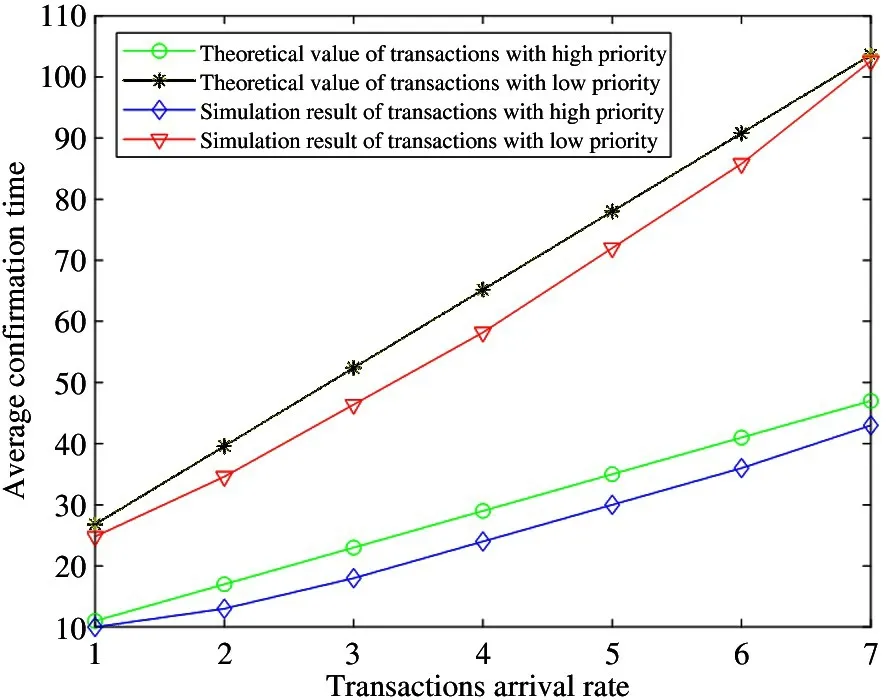
Fig.4 Impact of transaction arrival rateλon average confirmation time of transactions with different priority
Fig.5 shows the theoretical analysis and simulation results of the average confirmation time of transactions with high and low priority under different average block capacityλB(λ=5.0,μS=0.00042,η=0.8,N=150).With the increase of block capacity,the decline speed of average confirmation time of transactions with high and low priority gradually slows down.When the block capacityλBreaches about 200,the decline speed obviously decreases,which means raising the Block Gas Limit to expand the block capacity cannot significantly improve the transactions confirmation speed.
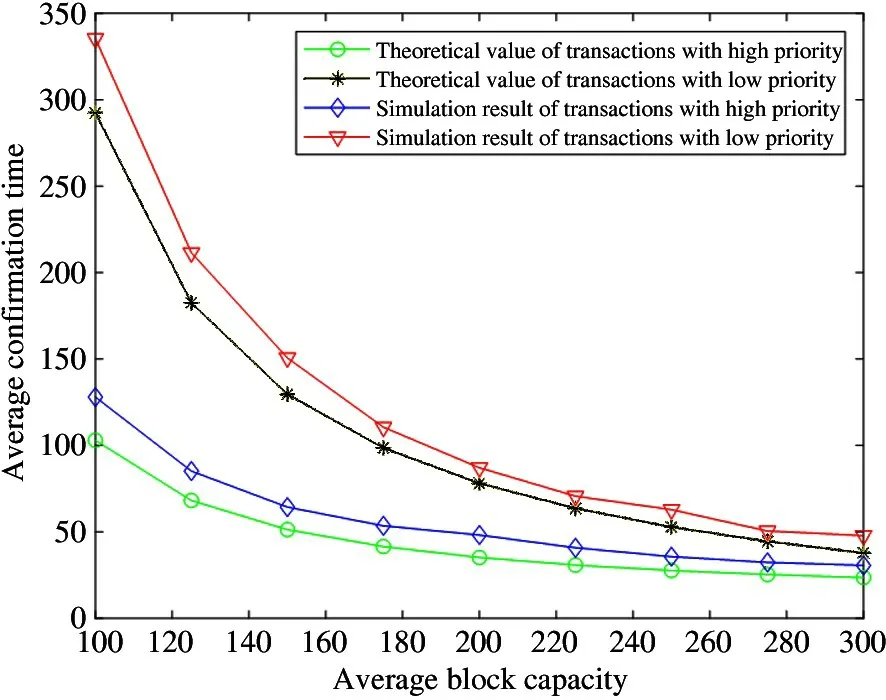
Fig.5 Impact of average block sizeλB on average confirmation time of transactions with different priority
Fig.6 shows the theoretical analysis and simulation results of the average confirmation time of transactions with high and low priority under different mean value of Gaussian distribution of service rates¯μ(λB=200,λ=5.0,η=0.8,N=150).With the increase of¯μ,the average confirmation time of transactions with high and low priority decreases at a slower pace,which shows that transactions are no longer remaining in the transaction pool because of the increasing speed of packing transactions.Therefore the transactions confirmation rate cannot be improved if the service rate continues to increase.

Fig.6 Impact of service rate¯μon average confirmation time of transactions with different priority
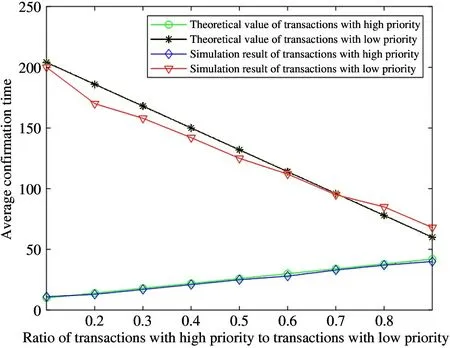
Fig.7 Impact of ratioηof transactions with high priority to those with low priority on average confirmation time of transactions with different priority
Fig.7 shows the average confirmation time of transactions with high and low priority under different arrival rate ratioηof high and low priority transactions(λB=200,λ=5.0,μS=0.00042,N=150).With the increase of the ratioη,the number of transactions with low priority decreases,so the average confirmation time of transactions with low priority decreases obviously,while the confirmation time of transactions with high priority increases slowly due to the increasing number of transactions with high priority.It shows that increasingηcan significantly shorten the average confirmation time of transactions with low priority,and has little impact on those with high priority.
Fig.8 shows the average confirmation time of transactions with high and low priority under different arrival rateλHof transactions with high priority(λB=200,λL=1.0,μS=0.00042,N=150).Fig.9 shows the average confirmation time of transactions with high and low priority under different arrival rateλLof transactions with low priority(λB=200,λH=1.0,μS=0.00042,N=150).When the arrival rate of transactions with high and low priority increases,the average confirmation time of transactions with low priority transaction increases gradually,and that of transactions with high priority increases slowly.It shows that even if the number of transactions queued in the transaction pool is large,the confirmation time of transactions with high priority will be slightly affected,while transactions with low priority will be greatly prolonged.
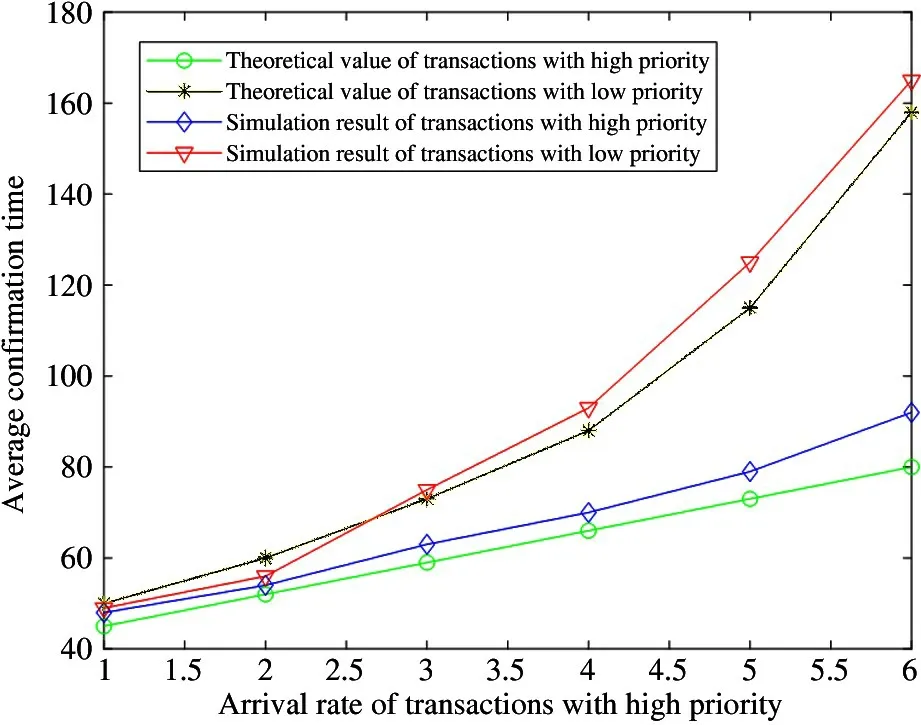
Fig.8 Impact of arrival rateλH of transactions with high priority on average confirmation time of transactions with different priority
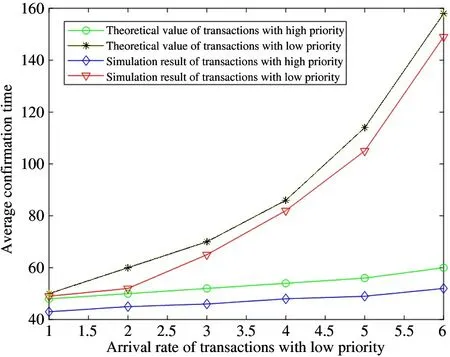
Fig.9 Impact of arrival rateλL of transactions with low priority on average confirmation time of transactions with different priority
Fig.10 and Fig.11 show the results of the average confirmation time of transactions with high and low priority under different number of nodesN(λ=5.0,λB=200,μS=0.00042,η=0.8).WhenN=20,the statistical characteristics are relatively unstable,and the simulation performance is deviated from theoretical analysis to a certain extent.WhenN=150 andN=20,the service rate of each node is close to the average service rate,so the simulation results are similiar to the theoretical value.
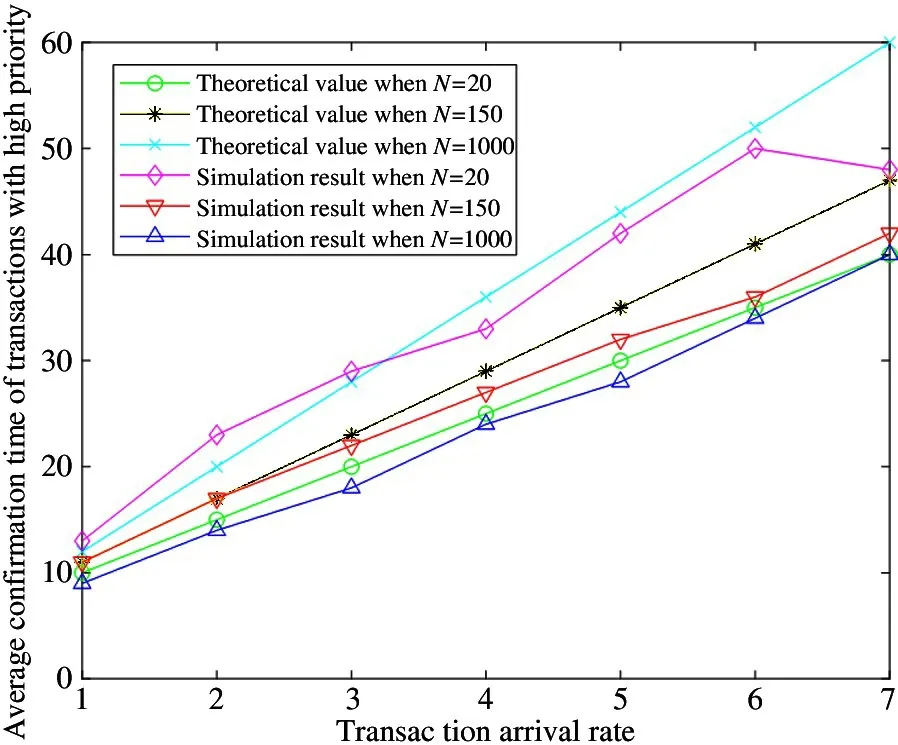
Fig.10 Impact of transaction arrival rateλand number of nodes N on average confirmation time of transactions with high priority

Fig.11 Impact of transaction arrival rateλand number of nodes N on average confirmation time of transactions with low priority
4 Conclusions
An Ethereum blockchain for civil aviation business data is proposed to promote the data sharing within civil aviation industry.A batch-service M/G/1 queuing model with variable service capacity is used to model the transactions confirmation process in the blockchain and calculate the average confirmation time of transactions with high and low priority.The effects of transactions arrival rate,average block capacity,average service rate,high-low priority ratio and number of nodes on the confirmation time of transactions with different priority are analyzed.The simulation results show that the model is effective,which provides theoretical support for the combination of civil aviation airport group and Ethereum blockchain,giving the basis for setting parameters such as transaction priority and Block Gas Limit.
猜你喜欢
杂志排行
High Technology Letters的其它文章
- On the performance of full-duplex non-orthonogal multiple access with energy harvesting over Nakagami-m fading channels①
- Research on optimization of virtual machine memory access based on NUMA architecture①
- Online prediction of EEG based on KRLST algorithm①
- Reconfigurable implementation ARP based on depth threshold in 3D-HEVC①
- Positive unlabeled named entity recognition with multi-granularity linguistic information①
- Behavior recognition algorithm based on the improved R3D and LSTM network fusion①
